Chicago has the Boxwood Blues
Boxwood Blight
Boxwood blight is the disease making headlines. This disease is a relatively new player in the Chicagoland region, and is more prevalent on the East Coast where it was first found in 2011. Boxwood Blight was discovered in Northern IL in 2016, and since then only three confirmed cases have been reported to the IL Dept of Agriculture (all have been successfully quarantined). The causal fungus, Calonectria pseudonaviculata, is referred to as a “sticky spore,” referring the fact that it mainly travels between host by hitching a ride on passing people, animals, or equipment. Initial symptoms show as dark spotting on infected leaves, which eventually grow to consume the entire leaf. The undersides of infected leaves and stems produce visible white spores following appropriate environmental conditions (warm and humid). The infection will quickly spread to the entire plant, causing rapid defoliation. A key identification of this infection is the black streaks that form on infected stems. While the disease does not infect root systems, its spores are able to survive up to five years once they fall to the ground.
Commonly the disease is introduced to new areas via infected nursery stock that has not yet shown symptoms. Once a plant is infected there is no cure, and the recommended action is to quarantine and remove all infected material. However, this should be done by a professional in order to reduce the further spread of the disease. There are preventative spray treatments available for healthy boxwood, but due to the aggressive spray program required for control, this is only recommended if the disease has been found within your neighborhood. The best management practice for this disease is prevention of introduction to your landscape, which is achieved through vigilant sanitation of pruning equipment and purchasing boxwood from reputable nurseries that routinely check for the disease.
It is highly unlikely that your boxwood have this disease. If your boxwood are looking tattered this spring, they more likely are suffering from one or more of the following ailments.
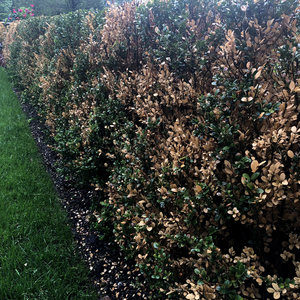
Typical winter injury on a boxwood hedge. The damage is focused on outer most growth and has a clean, bronzed appearance.
Winter Injury
Environmental damage has been extremely common this spring due to the harshness of the past winter. Winter damage can be cause by either excessive respiration which dries out the leaves, or by exposure to temperatures colder than its hardiness rating. Both result in a similar look: dried leaves starting from the outermost stems working inward, giving portions of the plant an alarming bronze or straw colored sheen. Additionally, late season snow events can cause flowing sap under the bark to freeze rapidly and expand, which physically blows the bark off the stem and girdles any live tissue terminal. Depending on the level of damage, some boxwood can recover from this one-time event. You may notice new growth forming on the interior of the plant, on the stem area just interior to where the dieback occurred. By carefully pruning the deadwood and exposing this new growth, you can successfully encourage new stems to fill the hole(s) caused by winter damage. However, you will need to be patient- boxwood grow very slowly and may take several years to regain their original shape.
You can reduce winter damage by applying an anti-desiccant spray.This oil is specially formulated to coat the evergreen leaves in a layer of wax and reduce drying out on sunny winter days.Additionally, you can plant cultivars such as “Green Velvet” that are comparatively more hardy than other cultivars available on the market.Winter damage can have devastating effects if compounded with additional stresses of other pathogens mentioned below.
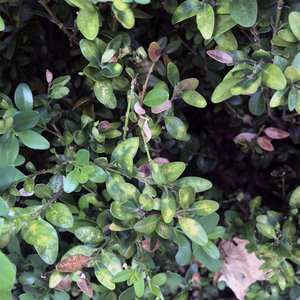
Boxwood leaf miner damage on new plant growth.
Boxwood Leaf Miner
Boxwood Leaf Miner is a very small insect (barely visible with a hand lens) whose larval stage feeds on the inner leaf space between layers of plant cells. Its feeding causes a circular discoloration and “blisters” to form on the leaves, with eventual leaf mortality. These foliar symptoms can be superficially similar to that of Boxwood Blight. However, if you suspect leaf miner damage you can physically peel apart the layers of the leaf to expose the yellow larva feeding on the leaves. On a plant with excessive infestation, you can sometimes hear a crackling noise emitting from the foliage as larvae are feeding.
Under normal conditions, this insect exists in low levels that would not warrant treatment.Occasionally, the insect will experience population swings and cause a localized outbreak.The Chicagoland area is currently experiencing a several year-long outbreak of this insect, and the damage can be severe enough to stress the boxwood host to the edge of death.This allows other, typically opportunistic diseases to move in and kill the plant.The control is either a contact insecticide applied as adults emerge in late spring, or a systemic insecticide applied in the spring or fall when larvae are feeding on the leaves.Several years of applications are required to see a positive affect, as feeding damage that appears in the spring/summer was likely caused by larva in the previous year.
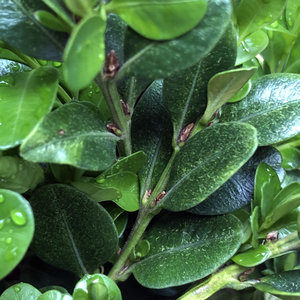
Spider mite damage on boxwood growth appears as a speckled, lighter color on otherwise healthy leaves.
Boxwood Spider Mites
Boxwood spider mite is commonly found on most species of boxwood. The mite, which overwinters as eggs on the underside of leaves, will hatch in May and immediately begin feeding on both the top and bottom sides of infected leaves. The feeding damage looks like a speckled pattern on the topside of leaf, as if someone has poked hundreds of tiny holes causing little tan colored spots to coat the entire leaf. Unlike many other spider mites, the boxwood spider mite does not produce significant quantities of webbing, so that cannot be used to identify their presence.
Mite feeding is most severe in years with excessive dry spells.Boxwood spider mites prefer the mild temperature of spring and early summer, and the feeding will slow when the temperature spikes. Due to the mites’ love of dry weather, a wet spring can adequately stymie their populations.For chemical control, these mites are best eradicated through multiple applications of either a dormant oil to kill overwintering eggs, or a mid-season miticide to target feeding adults.In a healthy landscape, natural predators should be able to keep spider mite populations in check.
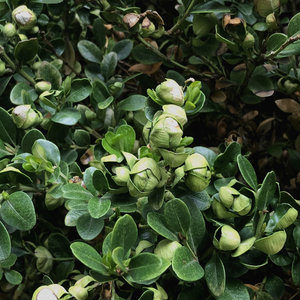
Boxwood psyllid damage causes cupping of terminal leaves of stems.
Boxwood Psyllid
The boxwood psyllid is a common insect pest of nearly all boxwood, but especially of our American species, Buxus sempervirens. The insect overwinters in bud scales, the overwintering plant structure that produces new growth in the spring and emerges as plants leave dormancy in May. As the crawler stage of the insect feeds on new growth, it causes a noticeable cupping habit to form on the newest leaves. This cupping action provides a safe environment for further feeding and eventual molting of the nymph into adults. The damage is considered purely aesthetic.
Normally psyllid damage is not observed in formal hedges where new growth is routinely removed. Psyllid control is easily achieved with a springtime insecticide when the nymphal stage is feeding, and rarely requires repeat application. However, when coupled with other pests, this insect can contribute to overall plant mortality and should be controlled when noticed.
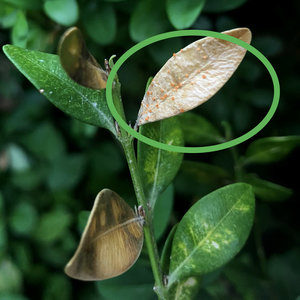
Volutella blight causes characteristic salmon colored fungal spores to appear on infected plant tissue.
Volutella Blight
Volutella Blight, sometimes referred to as Pseudonectria canker, is a common opportunistic fungal disease. It primarily infects stressed boxwood that has previously experienced winter injury, insect damage or excessive pruning. Volutella Blight has similar symptoms to boxwood blight, a much more serious fungal disease. The initial symptoms show little to no spring growth, often with the existing leaves becoming an orange or reddish color (indicating stress). Eventually, a stem canker will form causing the girdling and eventual death of the terminal stem. The canker will frequently cause the bark of the stem to peel off, leaving no chance for the terminal stem to recover. Unique to volutella blight is the salmon colored spores that form on infected stems and leaves during periods of high humidity. Another way to distinguish this disease from boxwood blight is by whether the leaves of infected stems are still present. Volutella blight infections will cause the leaves to stay on the stems for a significant period after death, whereas boxwood blight causes an alarmingly fast defoliation when conditions are right.
Once infected, you cannot cure and save the infected stem, but healthy stems can be preventatively treated with a spring fungicide. Since volutella blight is an opportunistic disease, the long-term cure is to promote healthy plant vigor through good cultural practices. Make sure your boxwood are adequately fertilized, and only water via drip irrigation or bubbler when needed. Boxwood do not like wet “feet” and suffer when prolonged rains cause saturated soils.
Boxwood are a favorite plant choice among many landscapes on the North Shore. This popularity has its’ drawbacks. Excessive monoculture planting can leave our collective urban landscape susceptible to a wide range of insects and diseases. It is not uncommon to see the same pathogen affecting multiple landscapes within the same neighborhood due to their proximity. However, most of the ailments described are treatable with the right diagnosis and care. For now, the spread of boxwood blight is successfully limited in the Chicagoland region through vigilant Arborist scouting and prompt ILDA response. It has the potential to be more prevalent in the landscape, but is currently highly unlikely to be affecting your boxwood. If your boxwood are struggling, it’s best to call your local certified Arborist to have a professional diagnosis. This allows the correct pathogen to be identified, and the proper treatment to be prescribed.
Early Spring Pests Spruce Spider Mites
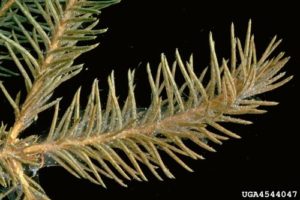
Figure 2: Webbing and excessive feeding damage on the terminal growth point of a spruce.(Source: USDA)
What is it:
The Spruce Spider Mite (Oligonychus ununguis) is a nearly microscopic pest that is closer related to spiders than true insects. This pest is a common feeder on most evergreens but is a major pest of both Arbor Vitae (Thuja occidentalis) and Colorado Blue Spruce (Picea pungens). These pests are nearly always present at low levels as part of a healthy ecosystem, and a healthy plant can thrive regardless of light feeding. However, unchecked their populations can quickly grow and cause significant damage to their host plant. This damage is often made worse when the host plant is under stress caused by poor cultural and environmental conditions.
The most common symptom is a stippled look to infested needles (Figure 1) caused by damage from their feeding. Spider mites feed on the chlorophyll found in plant cells and leave behind a creamy white spot wherever they feed. A single generation from egg to adult takes only 15-20 days, so this pest can rapidly outpace other beneficial insects keeping its’ population in check. An excessive population will leave fine webbing wherever they feed (Figure 2) and can cause dulling and premature drop of the host plants’ needles.
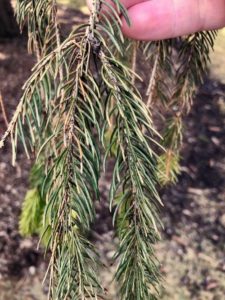
Figure 1: Typical stippling damage from Spruce Spider Mites on Norway Spruce. Heavier infestations will cause significant dulling of the needles and premature needle-drop.(Source: NJTE)
When and Where to find it:
This pest is a cool-season mite meaning it is active during the spring and fall, but the warm temperatures of the summer push it to dormancy. Look for activity to start in early April, as the Saucer Magnolia (Magnolia x soulangeana) comes into full bloom. Most commonly this pest is found on Colorado Blue Spruce and Arbor Vitae but can also be found feeding on Norway Spruce (Picea abies) and If you’re having a hard time seeing the common symptoms, a simple “smear test” help identify their presence. Hold a white piece of paper under the infested branch and shake the branch. Any mites present on the branch will fall to the paper. Next, smear your hand across the paper. If there are green streaks (indicating feeding on the plant), you have spider mites. If you have red streaks this is indicative of beneficial spider mites, who feed on the bad mites and keep their populations in check. Beneficial spider mites tend to be larger, visible with the naked eye and are bright red in color.
How to Treat it:
On the average healthy tree, no intervention is necessary. Light populations of spider mites do not significantly impede a trees’ ability to function normally. If you do notice excessive feeding or webbing on the plant, it may be time to treat. Several options are available, including miticide applications and horticultural oil sprays. Timing for miticide application is tight and must be applied when feeding is active in April or September/October. Horticultural oils control the dormant pests and therefore can be sprayed anytime during the spring or fall. However, some evergreens are sensitive to oil sprays and may go off-color if misapplied. Additionally, if you find beneficial mites on the host plant, you may want to hold off on treatment. Any spray that treats for Spruce Spider Mite will also knockdown any beneficial mites present and can exacerbate the problem. If you’re concerned about spider mite damage, it’s best to have you Nels Johnson Arborist decide which course of action is appropriate.
If you think you have spider mites, contact a Nels Johnson Arborist today for a free consultation.
The Importance of Being Furnaced
When the temperatures start to drop and the snow begins to fall, our minds inevitably wander to the thought of a cozy fire in the fireplace (or fire pit!). Before rushing to the store for your yearly supply of firewood, it’s important to consider the quality of the wood you’re purchasing. Firewood quality can vary dramatically, and is highly dependent on the process through which it was dried.
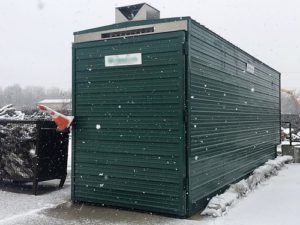
A picture of our kiln used up at the North Yard. Firewood is loaded into large crates and dried for up to 2 days at high temperatures to ensure low moisture content.
When lumber is harvested from a felled tree, the wood is considered too “green” to burn. This wood does not burn well, if at all, and produces smoke because of its high moisture content. Wet firewood is difficult to burn in home burners, fireplaces, and firepits. Prolonged use can adversely affect the performance of these heating systems. For effective combustion, firewood should have no more than 20 percent moisture content. To achieve this through traditional drying methods, firewood must air-dry for at least one season. However, a superior process is to utilize a kiln to aid in the drying process. A kiln is a thermally insulated chamber, a type of oven, that produces temperatures sufficient to complete the drying process.
The Benefits of Nels Johnson Kiln-Dried Firewood
Kiln-dried firewood is the cleaner alternative to traditional firewood. Grocers, retailers and even brick-oven pizza shops prefer this method of dry, sterilized, firewood. Besides producing a measurably consistent product, kiln-dried firewood provides the following benefits:
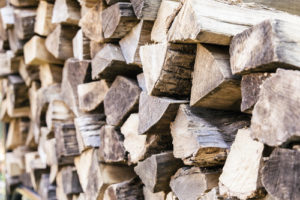
Our services include delivery and stacking of clean, insect-free firewood.
-
Kiln-dried firewood can be burned the day you get it; it ignites easily and burns efficiently.
-
It can be safely stored indoors. Kiln drying insures that insects, larvae, and mold are killed, making our firewood safe to store in your garage, porch, deck or living room.
-
Less flaking bark and debris (removed during the drying process) makes for tidier storage.
-
The wood produces a cleaner burn because it produces less creosote, which means fewer chimney issues, improved indoor air quality and less ash.
-
Kiln-dried wood provides a higher BTU (heat) output because energy is not being wasted to boil out excess moisture.
Our very own firewood specialist, Lisa Johnson, is responsible for overseeing the kiln-drying process at our North Yard. While the system is self-contained, it requires regular quality checks to ensure we consistently deliver a quality product with minimal moisture content. If you’re interested in learning more about the process, or are interested in purchasing, you can contact Lisa at (847) 475-1877. We can both deliver and stack your wood for you so you can spend more time enjoying the warm and enchanting fires this winter.
